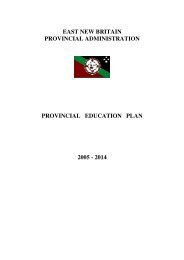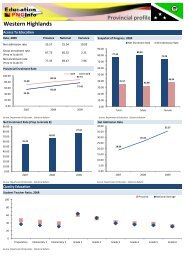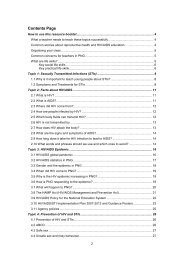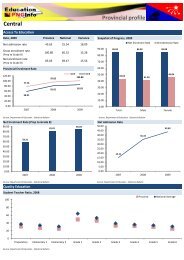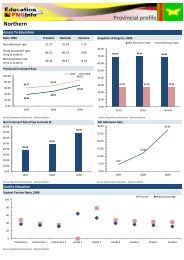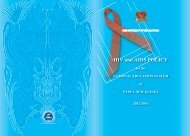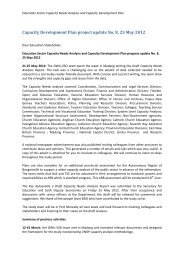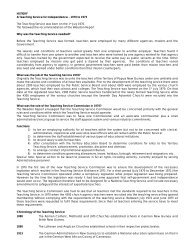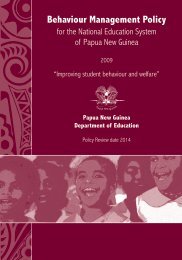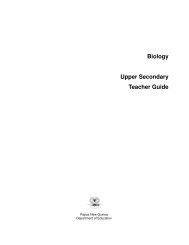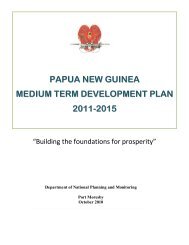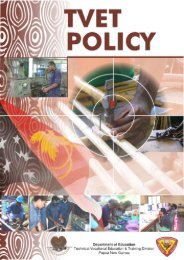Health Education to Prevent HIV/AIDS & STIs - Department of ...
Health Education to Prevent HIV/AIDS & STIs - Department of ...
Health Education to Prevent HIV/AIDS & STIs - Department of ...
Create successful ePaper yourself
Turn your PDF publications into a flip-book with our unique Google optimized e-Paper software.
<strong>Department</strong> <strong>of</strong> <strong>Education</strong> TVET Division<br />
<strong>HIV</strong>/<strong>AIDS</strong> & STI Teacher Guide<br />
Lesson 3<br />
By the end <strong>of</strong> this lesson students can…<br />
1.3 Explain the 3 common modes <strong>of</strong> <strong>HIV</strong> transmission<br />
1.4 State the 4 body fluids that transmit <strong>HIV</strong><br />
1.5. State ways <strong>HIV</strong> is not transmitted<br />
Resources: Butcher paper, Posters and leaflets on <strong>HIV</strong>/<strong>AIDS</strong> from the Provincial<br />
<strong>AIDS</strong> Committee, Student Resource Book (at least one between 2), questions<br />
displayed on butcher paper<br />
Introduction (15 mins)<br />
Ask the following questions <strong>to</strong> probe the students’ general knowledge on diseases.<br />
Which diseases seriously affect Papua New Guinea Ask them <strong>to</strong> list these diseases<br />
and the causes <strong>of</strong> these diseases. Ask volunteers <strong>to</strong> present their responses or<br />
answers <strong>to</strong> these questions. Then ask the pairs <strong>to</strong> sort them in<strong>to</strong> order <strong>of</strong><br />
seriousness.<br />
For example,<br />
Name <strong>of</strong> Disease<br />
Malaria<br />
Boil<br />
Flu<br />
Syphilis<br />
Worms<br />
<strong>HIV</strong>/<strong>AIDS</strong><br />
Tuberculosis (TB)<br />
Etc<br />
Cause <strong>of</strong> Disease<br />
Malaria parasite transmitted by<br />
mosqui<strong>to</strong>es<br />
Bacteria<br />
Virus<br />
Bacteria<br />
Parasite<br />
Virus<br />
Bacteria<br />
Etc<br />
Main body (40 mins)<br />
In the previous lesson students were asked <strong>to</strong> read through the first Module.<br />
Students are assigned in<strong>to</strong> small groups <strong>of</strong> 3-4. They need <strong>to</strong> answer these<br />
questions using their Resource Book.<br />
• What are the signs and symp<strong>to</strong>ms <strong>of</strong> <strong>HIV</strong> infection<br />
• What are the signs and symp<strong>to</strong>ms <strong>of</strong> <strong>AIDS</strong><br />
• What are the three main modes <strong>of</strong> <strong>HIV</strong> transmission<br />
• What are the four body fluids that transmit <strong>HIV</strong><br />
• How is <strong>HIV</strong> not transmitted List at least 8 ways.<br />
• What is the origin <strong>of</strong> <strong>HIV</strong><br />
• Should women with <strong>HIV</strong> breast feed or not<br />
Ask one group <strong>to</strong> present each answers and the other groups can correct and add<br />
information.<br />
Ask students <strong>to</strong> write one more question about this section <strong>of</strong> the Resource Book.<br />
They should ask a friend <strong>to</strong> try and answer this question.<br />
31



